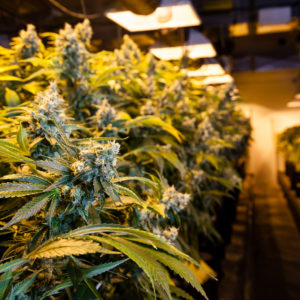Energy, like many industries, runs on data. Utilities measure the demand for power across residential and commercial settings, tracking fluctuations not only from season to season but also on a day to day basis. It is part of a metric that helps them predict user demand and to plan for future customer growth. Given the necessity of this type of information, the dearth of data about the energy needs of the budding legal cannabis industry is a surprising gap. Both regional utilities and industry groups are trying to obtain better information on power use for marijuana cultivation both now and projected into the future. The Resource Innovation Institute is looking to collect data submitted by growers in order to help build a resource efficient cannabis industry.
The Resource Innovation Institute aims to help cannabis growers learn from each other new ways to make their operations more resource efficient. One of the tools they have developed calculates a “Power Score” for growers. The survey both collects data about the energy usage of individual cannabis businesses and lets these businesses compare their performance to national averages.
Derek Smith, the executive director of the Resource Innovation Institute, admits that the primary goal of the survey is data collection, rather than industry education. The Power Score survey asks cannabis businesses about the type of license they hold, if they grow indoors or outside, and if they use natural or artificial light. The survey also asks growers about the wattage of lights they use and how long each day the lights are turned on.
Although still in a nascent form now, the survey is an important first step to gathering data about a growing sector of the economy that remains understudied. To date, there has never been a national baseline study of the power use of the cannabis industry, though utility companies in Colorado, Washington, and Oregon have studied the markets in those states.
The piecemeal studies that have been completed already show that the demand for electricity for marijuana cultivation will likely increase dramatically in the next 15 years. A study by the Northwest Power and Conservation Council, which helps to plan environmentally-conscious energy development in the Columbia River Basin, predicts that a regional load of 180 to 300 average megawatts will be used for indoor cannabis growth by 2035. The amount of power used by the industry could double by 2025.
The council used data for past production years to determine how much electricity was required to produce the cannabis consumed in Washington in 2014. It then combined these numbers with projected industry growth rates to determine the sorts of energy requirements the cannabis industry might have in the future.
The study found that the cannabis industry, despite its rather small size, was a significant part of the state’s power demand. Out of electric demand of 10,600 average megawatts cannabis production was slightly less than 1 percent of the total.
When it comes to agricultural commodities, marijuana is unique. Even in areas with fertile soil and a hospitable climate, like California, growers are loathe to move their fields outdoors. In states that have decriminalized recreational or medical marijuana, consumer desire for strains with different effects has led the industry not only to develop different strains, but also to carefully monitor every aspect of the growing process, from hours and intensity of light to humidity levels. This type of control allows growers to carefully tailor the THC and CBD levels in their crop, removing much of the variability otherwise present in agriculture. To do so, they almost always grow indoors, where conditions are easier to manage.
Due to the uncertain legal status of the industry, energy efficiency has not often been a focus. The Resource Innovation Institute reports that only 1 to 2 percent of growers are using LED lights, which reduce energy consumption but are more expensive to purchase.
As with many sections of the cannabis industry, questions remain unanswered. Until more utilities are able to gather information about their customers, it will be difficult to speak to the impact of cannabis cultivation on utility demands and to plan the generation equipment needed for future growth. In the meantime, studies like the Power Score survey may be some of the only hints into the industry’s power usage.

